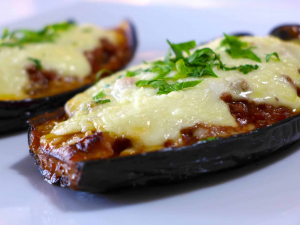XpatAthens
Greek Stuffed Eggplant Recipe
- 5 eggplants
- 500g minced beef
- 1 large red onion, finely chopped
- 2 cloves of garlic, finely chopped
- 1 glass of red wine
- 1 tin chopped tomatoes or tomato juice (passata)
- 1 cinnamon stick
- 1 tsp oregano
- 100g grated kefalotyri or any hard yellow cheese
- olive oil
- salt
- freshly ground pepper
- 2–3 tbsps chopped parsley
- 100g flour
- 100g butter
- 900ml milk (3 and 3/4 cups)
- 2 egg yolks
- a pinch of nutmeg
- 4 large potatoes, boiled
- 50g milk
- 1 tbsp butter
- 2 egg yolks
- Cut the eggplants into two pieces and carve them crosswise (the flesh). Season the eggplants and place them in a colander for about half an hour. Wash them with plenty of water and drain them on some kitchen paper.
- Preheat the oven to 200C. Season the eggplants with salt and pepper and drizzle with olive oil. Place the eggplants (with the skin facing up) in a baking tray, lined with parchment paper. Bake the eggplants for 40 minutes, until softened.
- In the meantime, prepare the meat sauce for the ‘papoutsakia’. Peel and chop the onions and garlic. Place a large pan on medium heat, add some olive oil and the onions and sauté, until softened. Stir in the garlic and sauté. Turn the heat up, add the minced beef breaking it up with your spoon and sauté. Deglaze with the red wine and wait 1-2 minutes to evaporate. Stir in the canned tomatoes, the cinnamon stick, a pinch of sugar, the oregano, and season. Bring to the boil, turn the heat down and simmer with the lid on for about 30 minutes, until most of the juices have evaporated. In the end, add 1-2 handfuls of grated cheese and chopped parsley and stir.
How To Use Technology Mindfully
1. Record Screen Time
2. Turn Do Not Disturb mode on
3. Declutter your phone
4. Stop using your phone at least an hour before going to sleep
XpatAthens Open Call For New Leadership
XpatAthens has been serving the international community since 2007 as the main digital resource for foreigners living, working, and traveling in Greece.
- Receiving grant support from the Stavros Niarchos Foundation
- Completing nonprofit status with Google for Nonprofits
- Successfully transitioning into operating as a Greek nonprofit
- Full autonomy - We have brought this platform to where it is today and are looking for new, experienced, and able leadership to take it into the future. The existing team may be utilized if desired.
- A new director - A new and experienced leader is needed. As a nonprofit organization, this individual will have responsibility for running day-to-day operations, including reporting to a Board of Advisors.
- A board of advisors - This will be the first time that our organization has a Board and it will be up to the new leadership to select their Board.
- Seek financial support - We are active in our outreach for financial support and this must be continued. Our existing channels include: private, donors, corporate sponsors
For additional information, you can:
Visit our website.
Learn more about us.
Read our mission statement.
We’re excited to see who will be part of what’s next for this amazing platform. Cheers from the XpatAthens team!
The Enchanting Beauty Of Greece's Aesthetic Forests



@stavrossif

@mikelapardas

@iliasnikoloulis
Registered Address Services By WHEN Hub
(includes 3.6% stamp duty; original price: €80/month + 3.6% stamp duty)
-
Mail handling
-
1 locker
-
8 hours/month access to a flex desk
-
Phone booth (up to 2 hours/month)
-
Meeting room (1 hour/month)
(includes 3.6% stamp duty; original price: €225 + €80/month with 15% discount)
-
Mail handling
-
1 locker
-
Unlimited monthly access to flex desk
-
Phone booth (up to 20 hours/month)
-
Meeting room (10 hours/month)
Why Choose WHEN Hub?
-
Email: hub@when.org.gr
-
Phone: 211 218 1642 / +30 211 218 1643
-
Address: 29 Sokratous Street, 10552 Athens, Greece
Karditsa Prefecture
One usually thinks of Greece as an archipelago of a lot of islands. Yet, Karditsa can surprise its visitors with mountain landscapes as dramatic as one can see in the Alps, just one of many places of incomparable beauty in this region. Lake Plastiras, lying in the magnificent valley of the Agrafa Massif, welcomes its visitors with hotels and hostels designed to merge with the natural environments, and also equipped to satisfy even the most demanding clientele.
Here you will be able to enjoy thoroughly unspoiled landscapes that have only recently attracted the attention of international Nature lovers.
Along the lakeside road, a series of pavilions and small shops invite visitors to savor the exquisite traditional tastes and fragrances of the region’s particular delicacies. Locally produced pastry and confections, wine, and other specialties await to introduce the traveler to the real joys of Karditsa Prefecture.
One occasion you would not want to miss is the Carnival manifestations in Sofades, a few kilometers away from the capital of the Prefecture. They take place in the beginning of spring, and they signal the end of winter, still visible in the snow-capped mountains and hills in the distance.
The lightheartedness of time is reflected in the morning smile of the lake. Now, the excursions in the region's lower mountains, to a series of breathtaking sites centered on Plastiras Lake or in the Town of Karditsa, are a real enjoyment; from historic Ellinopyrgos to the cool Kanalia and Fanari, where the well-preserved old castle dominates the plain below. Another trip, a short ten kilometers from Karditsa Town, brings us to Aghios Athanassios hill, where we can see the remains of the Byzantine castle, now ruined, built with the stones of the ancient acropolis of Kalithiros, known from Hellenistic times (3rd to 1st centuries B.C.). On our way back, Aghios Georgios Village and its church are worth a visit.
To read more, please visit windmillstravel.com
Greece To Try For Loan Extension From Eurozone
Greece is set to submit Wednesday to the Eurogroup a request for a six-month extension to its loan agreement with its creditors, sources close to the negotiations between Athens and the eurozone told Kathimerini Tuesday.
While the request from Athens could help the two sides overcome the impasse reached at Monday’s Eurogroup, the fact that Greece will purportedly ask to extend its loan agreement rather than its program could lead to complications.
The Greek side is apparently willing to agree to a moratorium on any steps that could affect the country’s fiscal targets and is ready to discuss other measures but is not willing to adopt the terms of the existing bailout. The proposal is due to be sent to Eurogroup chief Jeroen Dijsselbloem this morning and the Dutch finance minister will decide if it merits calling an extraordinary meeting of eurozone finance chiefs for Friday.
A European Union official told Kathimerini’s Brussels correspondent Eleni Varvitsioti that the problem with Greece asking for an extension of its loan agreement and not the terms that come with it may create problems in parliaments such as Germany’s, which have to approve the prolongation of the agreement.
To read more, please visit ekathimerini.com
Spring Sales In Athens: May 2 - 9
Happy shopping!!
Rhodes To Host Tripadvisors Destination Academy Europe
August 14 - It's Holiday Time Across Greece
Remember to stay connected with us through our weekly newsletter, Facebook, and Twitter!













